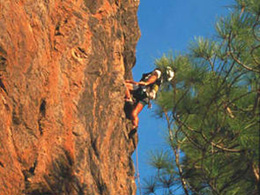The delightful climate and the outstanding volcanic terrain that have made Gran Canaria a leading international holiday destination, have also created the perfect setting for non-winter mountain sports. One of the most popular of these is rock climbing, which has an unexpected paradise of rocks and vertical cliffs waiting to be discovered in the island that has generated some important school sites. The constant opening of new and more difficult routes, together with the growing number of climbers and clubs give us an idea of just how fast this sport is catching on.


A climbing wall called Gran Canaria
The volcanic relief of Gran Canaria was constructed by three major periods of volcanic eruptions over a period of 16 million years. The oldest rock, spewed forth as lava flows, are ideal for climbing, even though they vary in composition and lithology, because they are solid and they are not slippery. Erosion put the final touches to moulding the elements that are now characteristic of the island landscape: gullies, cliffs, crests, cauldrons, rock needles This landscape offers a complete repertoire of cracks, chimneys, plates, wedges, overhangs, ceilings, etc, that turn the whole island into one immense climbing wall with an infinity of possibilities to be discovered. There are presently climbing sites all over the island, although the most popular areas and climbing schools are found at the sites with good access and the best rock.
Climbing areas
In the mountain peaks, there are outstanding areas like Roque Nublo, a rock needle of excellent basalt conglomerate with 12 beautiful routes and an endless variation of difficulty, which is the natural symbol of Gran Canaria and the origin of climbing on the island. Other highland rock needles that can be climbed are El Palmés, in El Toscón de Tejeda, Betancuria in Ayacata or Narices, at the foot of the north face of Roque Bentayga. Climbing is restricted on this latter rock, because of its archaeological value.

Close to El Nublo is the rock circus of Ayacata, a sanctuary of traditional climbing with the largest number of classical routes of different lengths and degrees of difficulty, scattered over the areas known as La Librería, El Frontón del GEC, La Candelilla, El Montañón. Somewhat further away, El Pino and El Aserrador, offer the highest routes on basalt conglomerate walls on the island.
Tamadaba, an ancient mountain massif covered in pine forests and vertical cliffs, is in the north west, rising over the sea to an altitude of over 1000m. On its upper lave flows, you can find the sites of Lomo Caraballo, Supernova, la Perfumería and El Gulich, with its famous Emiliano Zapata route, which made this area the sports climbing capital of Gran Canaria.
Other sites include Costa Ayala, a former climbing school, Bañaderos, sea cliffs located 3 km and 14 km respectively, from Las Palmas de Gran Canaria, along the northern motorway GC2, and Las Meleguinas, next to the bridge of the same name, in the borough of Sta. Brígida.

On the walls moulded by the erosion of rain and streams, and the blocks of the gullies of the south of the island, you can find the main setting of the new school of sports climbing and boulder climbing. La Sorrueda, very near Santa Lucia, in the Tirajana gulley, the leading site for sports climbing in the south of Gran Canaria and, together with Fatagonia, in the neighbouring Fataga gulley, close to the village of the same name, the sites that attract the most climbers. The southern gullies of Berriel and Ayagaures.
Recommendations
With the exception of a few publicly owned places, military sites or sites of special ecological sensitivity, climbing is allowed everywhere. The only restrictions are the regulations governing the use and enjoyment of natural areas; avoid any environmental impact or damage to the inhabitants of the countryside and their way of life.
Sports climbing does require the regulation papers: federation license, insurance policy covering civil liability, accident, etc. We recommend you acquire more detailed and more up to date information about climbing sites, regulations, equipment, etc, from the Canary Island Federation of Mountaineering and Climbing, or that you go with local climbers.
Climbo
Address: Paseo Tomás Morales 68, 1ºA
Telephone: (+34) 636 898 493 / (+34) 687 512 500
Web: www.climbo.rocks